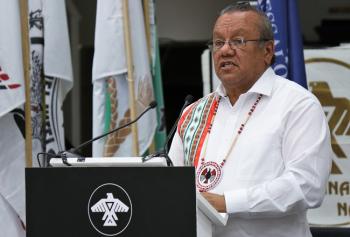Image Caption
Summary
Local Journalism Initiative Reporter
Windspeaker.com
The federal government’s “interim” education funding formula for First Nations is increasingly raising the hackles of some leaders.
The Chiefs of Ontario have decided to pursue direct “bilateral” talks with Indigenous Services Canada on education funding instead of leaving it to an Assembly of First Nations committee.
“Just treat us fairly. That’s all we’re going to ask for,” explained Grand Council Chief Glen Hare, representing the 39-member Anishinabek Nation, in an interview with Windspeaker.com on Friday. “Give us the authority. Don’t make us ask you ‘Can we do this? Can we spend on this?’
“We now have our own Education Act in Anishinabek Nation. We have lots of technical, smart people in education who can do this. Our people are really anxious to get going. We want ownership of education.”
Nearly two years ago, the federal government announced a new “interim” education funding formula for First Nations. It relies on a “comparability” approach, linking dollars to individual provinces’ school budgets.
Indigenous Services Canada insists that its new approach—it said “co-developed” with First Nations leaders—has improved funding for schools. The table, however, remains open to addressing specific concerns as ISC devises a longer-term plan for education on reserves across the country, reports the ministry.
Further to the west of the country, the Confederacy of Treaty 6 chiefs released a statement Jan. 21 on education funding, arguing Ottawa’s plan “is inconsistent with the treaty right to education.”
“The Treaty No. 6 First Nations were not consulted,” the statement reads. “This approach was initiated without free, prior and informed consent of the nations.
“Life-long learning Education is a Treaty and Inherent Right and First Nations have a right to control all aspects of education, from early childhood through post-secondary which must be honoured and respected.”
Confederacy Grand Chief Vernon Watchmaker was not available for an interview about the concerns. Nor was the Assembly of First Nations’ executive’s point-person on the education portfolio, Regional Chief Bobby Cameron.
“The funding provided to First Nation communities through this new interim funding formula can be used flexibly to address local education priorities,” said William Olscamp, an Indigenous Services Canada spokesperson, in an email.
He said the new interim funding formula, in effect since April 2019, does rely on “components” of each province’s education funding “as a base” to measure costs of school services, including “remoteness, school size, language and socio-economic conditions.” And the department insisted the formula is, in fact, “interim” and open to reform.
“Refinements to the funding approach are continually occurring,” Oscamp explained, “through discussions with Indigenous Services Canada and First Nations at technical tables.”
Windspeaker.com recently learned that the Chiefs of Ontario are increasingly concerned about school dollar losses under the federal model and they have grown disenchanted with the Assembly of First Nations education committee process. Nishnawbe Aski Nation Deputy Grand Chief Derek Fox — who oversees the Chiefs of Ontario's education portfolio — revealed First Nations education funding plummeted by four per cent, or roughly $5 million over a 12-month period.
As a result, Ontario chiefs held an "emergency meeting" and have entered direct bilateral talks with Indigenous Services Canada on funding, effectively cutting out the Assembly of First Nations National Chiefs Committee on Education.
“It’s not pulling out, really,” Chief Hare explained of the decision to push for direct talks with ISC. “We’re still in the organization. We just feel we can do a lot more if we did our own thing in Ontario.
“I’m part of the leadership table at the Chiefs of Ontario. We’re very much on side with all the chiefs; this is not just the grand chief’s decision … There’s too much talk; meetings and meetings and committees just don’t cut it anymore. Let’s stop talking and get going.”
The AFN education committee plans to host a virtual forum on current Indigenous education issues March 3 and March 4, titled "Reclaiming and Reimagining First Nations Education."
According to the committee’s website, the national umbrella organization is pushing for “special measures in order to enjoy (First Nations’) right to education on an equal footing with non-Indigenous students,” with particular demands for “the right to equitable funding that meets their specific needs and circumstances, taking into account First Nations children’s cultural, linguistic, and geographical needs, as well as historical realities.”
First Nations leaders in Ontario and Alberta are not alone in their concerns. The Yellowhead Institute, an Indigenous think tank, has raised concerns about the interim funding formula since it was unveiled in 2019.
It published a report raising concerns that the new federal approach essentially holds First Nations’ schooling hostage to whichever provincial government is in power, because of what’s known as a “comparability model” that bases funding on comparable provincial dollars spent.
“Most troublesome and most damaging to First Nation control is how intricately tied the comparability model is to provincial education lawmaker’s decisions,” said Anishinaabe report author Leslee White-Eye, former chief of the Chippewas of the Thames First Nation, with the First Nations with Schools Collective.
“How schooling is defined, implemented and funded is now squarely dictated by the provincial government.”
However, according to White-Eye, on the other hand the cash injections from the funding formula came as “a welcome reprieve for many First Nations who, since the mid-1970s, have been administering chronically underfunded schools.”
But the Yellowhead researcher noted that Ottawa’s plan, though ostensibly temporary, could pose long-term dangers to Indigenous self-determination over education, which is closely tied to what funding is available and who makes decisions over which educational programs are funded.
“Left absent from the comparability model is accountability, power, authority and control,” said White-Eye. “Even if this is interim, this current approach will become the benchmark for change later, preempting any innovation a First Nation-specific needs funding approach that doesn’t look or feel like a conventional school board model will bring.
“This is a significant danger.”
—With files from Shari Narine, Windspeaker.com

